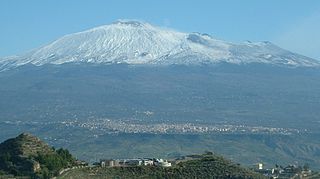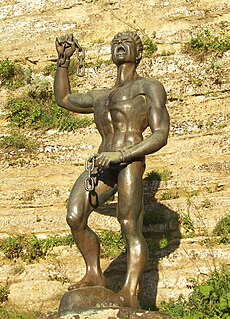
The 1st century BC, also known as the last century BC, started on the first day of 100 BC and ended on the last day of 1 BC. The AD/BC notation does not use a year zero; however, astronomical year numbering does use a zero, as well as a minus sign, so "2 BC" is equal to "year –1". 1st century AD follows.

The First Servile War of 135–132 BC was a slave rebellion against the Roman Republic, which took place in Sicily. The revolt started in 135 when Eunus, a slave from Syria who claimed to be a prophet, captured the city of Enna in the middle of the island with 400 fellow slaves. Soon after, Cleon, a Cilician slave, stormed the city of Agrigentum on the southern coast, slaughtered the population, then joined Eunus' army and became his military commander. Eunus even proclaimed himself king, under the name of Antiochus, after the Seleucid emperors of his native Syria.
Gaius Verres was a Roman magistrate, notorious for his misgovernment of Sicily. His extortion of local farmers and plundering of temples led to his prosecution by Cicero, whose accusations were so devastating that his defence advocate could only recommend that Verres should leave the country. Cicero's prosecution speeches were later published as the Verrine Orations.

The Sicilian Vespers was a successful rebellion on the island of Sicily that broke out at Easter 1282 against the rule of the French-born king Charles I, who had ruled the Kingdom of Sicily since 1266. Within six weeks, approximately 13,000 French men and women were slain by the rebels, and the government of Charles lost control of the island. This began the War of the Sicilian Vespers.

The Kingdom of Sicily was a state that existed in the south of the Italian peninsula and for a time the region of Ifriqiya from its founding by Roger II of Sicily in 1130 until 1816. It was a successor state of the County of Sicily, which had been founded in 1071 during the Norman conquest of the southern peninsula. The island was divided into three regions: Val di Mazara, Val Demone and Val di Noto; val being the apocopic form of the word vallo, derived from the Arabic word wilāya.
The Second Servile War was an unsuccessful slave uprising against the Roman Republic on the island of Sicily. The war lasted from 104 BC until 100 BC.
The Servile Wars were a series of three slave revolts in the late Roman Republic.

The Mithridatic Wars were three conflicts fought by Rome against the Kingdom of Pontus and its allies between 88 BC and 63 BC. They are named after Mithridates VI, the King of Pontus who initiated the hostilities after annexing the Roman province of Asia into its Pontic Empire and committing massacres against the local Roman population known as the Asian Vespers. As Roman troops were sent to recover the territory, they faced an uprising in Greece organized and supported by Mithridates. Mithridates was able to mastermind such general revolts against Rome and played the magistrates of the optimates party off against the magistrates of the populares party in the Roman civil wars. Nevertheless, the first war ended with a Roman victory, confirmed by the Treaty of Dardanos signed by Lucius Sulla and Mithridates. Greece was restored to Roman rule and Pontus was expected to restore the status quo ante bellum in Asia Minor.

Adrano, ancient Adranon, is a town and comune in the province of Catania on the east coast of Sicily.

Sicilia was the first province acquired by the Roman Republic, encompassing the island of Sicily. The western part of the island was brought under Roman control in 241 BC at the conclusion of the First Punic War with Carthage. A praetor was regularly assigned to the island from c.227 BC. The Kingdom of Syracuse under Hieron II remained an independent ally of Rome until its defeat in 212 BC during the Second Punic War. Thereafter the province included the whole of the island of Sicily, the island of Malta, and the smaller island groups.

The Asiatic Vespers refers to the genocide of Roman and other Latin-speaking peoples living in parts of western Anatolia in 88 BC by forces loyal to Mithridates VI Eupator, ruler of the Kingdom of Pontus, who orchestrated the massacre in an attempt to rid Asia Minor of Roman influence. An estimated 80,000 people were killed during the episode, which is considered one of the deadliest recorded genocides in Classical antiquity. The incident served as the casus belli or immediate cause of the First Mithridatic War between the Roman Republic and the Kingdom of Pontus.

Eunus was a Roman slave from Apamea in Syria who became the leader of the slave uprising in the First Servile War in the Roman province of Sicily. Eunus rose to prominence in the movement through his reputation as a prophet and wonder-worker and ultimately declared himself king. He claimed to receive visions and communications from the goddess Atargatis, a prominent goddess in his homeland whom he identified with the Sicilian Demeter. Some of his prophecies were that the rebel slaves would successfully capture the city of Enna and that he would be a king some day.

The War of the Sicilian Vespers or just War of the Vespers was a conflict that started with the insurrection of the Sicilian Vespers against Charles of Anjou in 1282 and ended in 1302 with the Peace of Caltabellotta. It was fought in Sicily, Catalonia and elsewhere in the western Mediterranean between the kings of Aragon on one side against the Angevin Charles of Anjou, his son Charles II, the kings of France, and the Papacy on the other side. The war resulted in the division of the old Kingdom of Sicily; at Caltabellotta, Charles II was confirmed as king of Sicily's peninsular territories, while Frederick III was confirmed as king of the island territories.

The history of Sicily has been influenced by numerous ethnic groups. It has seen Sicily controlled by external powers – Phoenician and Carthaginian, Greek, Roman, Vandal and Ostrogoth, Byzantine Greek, Aghlabid, Kalbid, Norman, Aragonese and Spanish – but also experiencing important periods of independence, as under the indigenous Sicanians, Elymians and Sicels, and later as the Emirate of Sicily, County of Sicily, and Kingdom of Sicily. The Kingdom was founded in 1130 by Roger II, belonging to the Siculo-Norman family of Hauteville. During this period, Sicily was prosperous and politically powerful, becoming one of the wealthiest states in all of Europe. As a result of the dynastic succession, then, the Kingdom passed into the hands of the Hohenstaufen. At the end of the 13th century, with the War of the Sicilian Vespers between the crowns of Anjou and Aragon, the island passed to the latter. In the following centuries the Kingdom entered into the personal union with the Spaniard and Bourbon crowns, preserving however its substantial independence until 1816. Although today an Autonomous Region of the Republic of Italy, it has its own distinct culture.
Vespers is the Catholic and Orthodox prayer service.

Sicilian nationalism is a movement in the autonomous Italian region of Sicily, as well as the Sicilian diaspora, which seeks greater autonomy or outright independence from Italy, and/or promotes further inclusion of the Sicilian identity, culture, history, and linguistic variety.

Forte del Santissimo Salvatore, also known as Castello del Santissimo Salvatore, is a fort in Messina, Sicily. It was built in the mid-16th century, and it is still military property. Some of its walls were demolished after the earthquake of 1908, but the rest of the fort is still intact.












